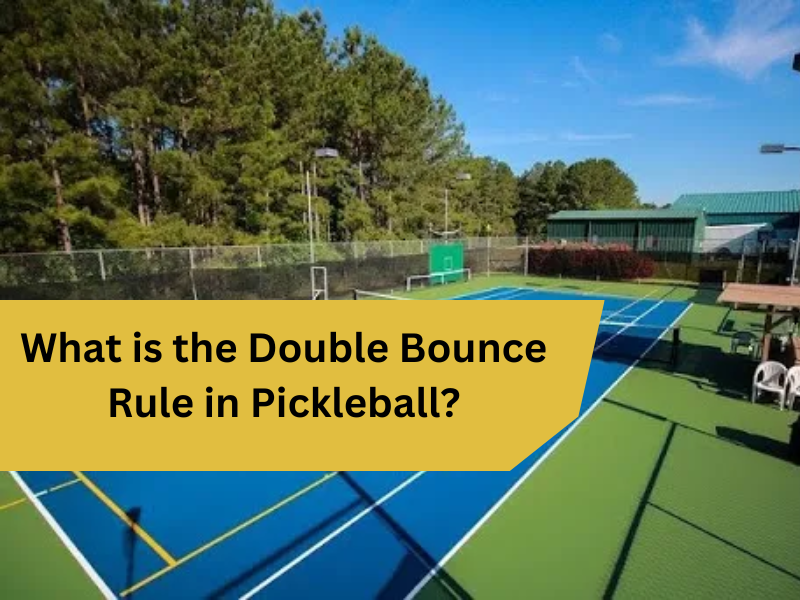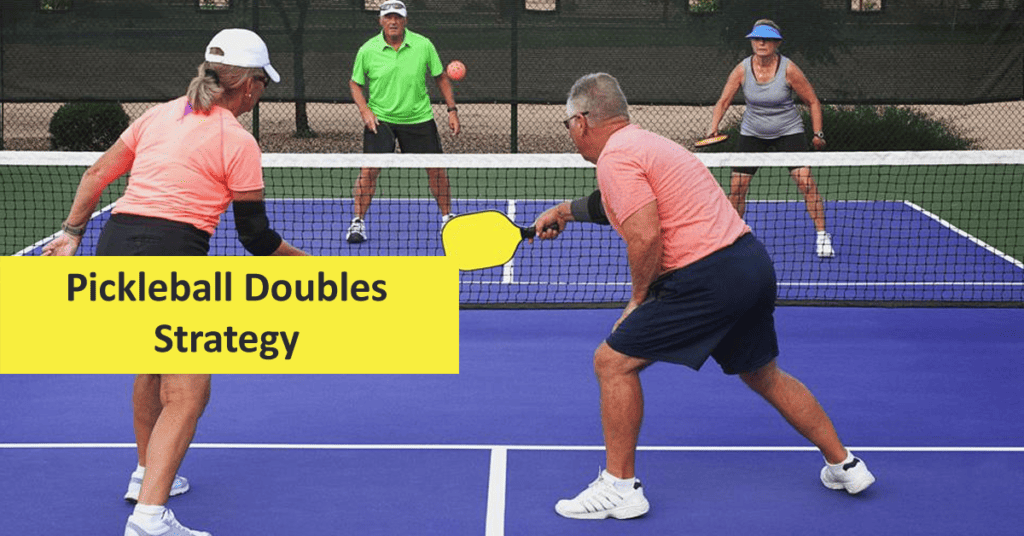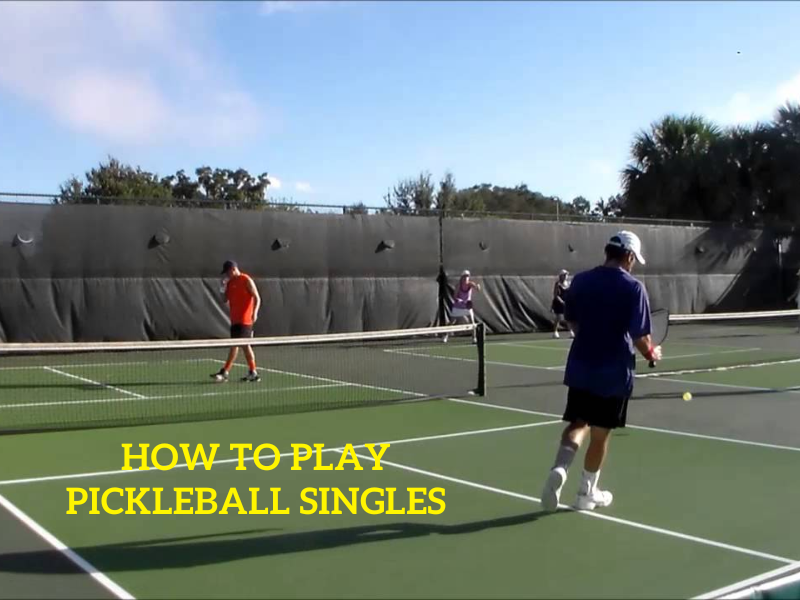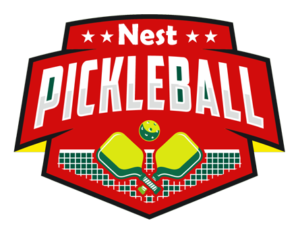The double bounce rule is a guideline to determine which balls a player should bounce when playing a rally. It’s not set in stone because rules aren’t perfect.
So, what is the double bounce rule in pickleball?
The “Double Bounce Rule” in pickleball mandates that after the ball is served, it must bounce once on the receiving team’s court before being returned. Subsequently, when the ball is returned, it must bounce once on the serving team’s court before being played. Essentially, the first two hits of the rally (the serve and its return) must be allowed to bounce, ensuring that both teams have one groundstroke each. After these initial bounces, players can volley the ball or play it off a bounce. This double bounce pickleball rule adds a distinct tactical depth to pickleball, preventing immediate aggressive net plays right from the serve.
If you want to learn about the double bounce rule pickleball, read on. You’ll know how to calculate the maximum number of bounces per game and the maximum number of shots a player can take during a match.
Double Bounce Rules in Pickleball
Official Rule:
Two-Bounce Rule: Each side must make one groundstroke after the ball is served before volleying.
The double bounce rule in pickleball states that if the player who serves hits the ball once and lands on the baseline, the serve can be considered a good shot and called a serve. However, if the player hits the ball twice, the second hit is regarded as the pickleball bounce serving action, and the player can declare the serve as a “bad” shot.
Therefore, if the server hits the ball three times and declares the third hit as the serving action, the ball is called a bad shot. If you understand these two concepts, you can understand the pickleball double bounce rules in detail.
The Core of the Double Bounce Rule
The best way to serve pickleball to ensure that both players get some points in a rally is to require the serve and return pickleball serve rules to bounce. The double bounce call requires that both players get the point whenever either of the two serves bounces twice. The double bounce rule has the greatest effect if applied to rallies of more than five points.
If you are playing doubles tennis, you should have the doubles team follow the double-bounce rule. For example, if you have a rally of eight points, you and your partner should get one point for each bounce on the server’s side.
If you have a rally of 12 points, the rules require that you and your partner each get two points for the first bounce and that the second bounce should be a serve for you to receive a point.
The double bounce rule pickleball also requires that your partner serves your opponent for longer rallies. For example, you and your partner might be playing a nine-point rally. After you win the first point, your partner must serve you. That means you can only get the next point once your partner serves again. You’ll get a point for each bounce on the return serve.
Basic Double Bounce Concept in the Pickleball
However, the double bounce rule in pickleball is a basic concept in the sport. If the server does not hit the ball twice, the serve cannot be declared a bad shot. The server should focus more on hitting the ball twice and declaring it a serve.
The following points are the double bounce rule in pickleball:
Pickleball Double Bounce Rules
DOUBLE BOUNCE RULE
- Good Shot
- One shot only
- Bad Shot
- Two or more shots
It is considered a serve when the server hits the ball once and bounces twice on the baseline.
It is a serve when the server hits the ball twice and rebounds on the baseline.
The double bounce rule in pickleball helps pickleball players to become better at the game. Knowing the double bounce rule in pickleball will make you a better player.

When Does the Ball Have to Bounce in Pickleball?
In pickleball, the ball must bounce once on each side of the net before players can volley it (hitting it out of the air without letting it bounce). This rule creates what’s known as the “double-bounce rule” or “two-bounce rule.” Specifically:
- On the serve: The ball must bounce in the receiving side’s court before being returned.
- On the return of serve: The ball must bounce again on the server’s side before it can be volleyed.
After these two bounces (one on each side), players can volley the ball or let it bounce before returning it. This rule ensures that the serving team cannot rush the net immediately after serving, adding a unique strategic element to the game.
What Did Double Bounce Rules Say?
The double bounce rule says that the ball does not bounce twice on the same courtside if both bounces are within 6 feet of the baseline. This is to prevent the player from hitting a shot with their racquet after a bounce to get a good look at the ball or change sides.
What is the Purpose of the Double Bounce Rule?
According to our research, the double bounce rule was created by Catherine Parenteau and Bill Bell, the world champion of the sport of pickleball, in 1965, when he noticed that people would bounce their paddles off the side of the table after hitting the ball.
When players hit the ball near the edge of the table, it bounces back onto the court, allowing the opposing player to return it to the court. The bouncing double pickleball rule is meant to prevent a player from hitting the ball and returning it before the player who hit the ball has had an opportunity to respond.
Who Benefits From the Double Bounce Rule?
It is possible that the double bounce pickleball rules strategy and rules can be a massive advantage in many sports. For instance, if a golfer hits a ball that bounces twice, he will likely make a putt or two.
The pickleball double bounce rules allow players who lose balls at the net to continue playing. In some cases, even the double bounce rule scores more points.
Players who experience doubles during pickleball matches often have to deal with frustration, but this does not translate into lost games. Instead, the double bounce rule allows players to recover from mistakes.
One of the double bounce rules in pickleball’s most obvious benefits is that the ball never gets stuck inside a court. In pickleball, the double bounce rule allows players to bounce the ball from both sides of a net.
In tennis and racquetball, the ball bounces only off the ground. While this may seem like a minor difference, it can have a significant impact when your opponent is close to the net. By bouncing the ball from both sides of the net, you can get away from your opponent, who may be trying to stop you from scoring.
Why Does the Double Bounce Rule Exist?
It’s easy to figure out why the double bounce rule exists, but the reason why it doesn’t come as quickly. Let me explain what I mean by this. The double bounce rule exists because it provides more options and opportunities for players to participate in pickleball (this includes more scoring opportunities).
It was implemented to improve the game’s overall quality by ensuring a more balanced experience for everyone.

If everyone hits the ball back simultaneously, there’s no competition, which means no one is forced to make a choice or decision in which they may be uncomfortable.
Is the “Double Bounce Rule” and The “Two Bounce Rule” the Same Thing?
How often have you used the “Double bounce rule” or the “two bounce rule”? This phrase is commonly heard when pickleball players discuss their games or gameplay. What the double bounce rule means is that after every rally (a point where two opposing players compete against each other), there are two points where a player can legally hit a ball.
At the same time, the two-bounce rule states that a player must hit the ball at least twice within the rally period before hitting the ball out of bounds.
What is the Double Bounce Rule, aka two bounce rule in pickleball?
The double bounce rule, aka two bounce rule in pickleball, is a safety rule that prevents a player from hitting a ball directly with the paddle and sending it back towards the players.
An excellent example is when a player is serving and wants to return the ball with their paddle differently (like going behind the chair), they have to touch the ground with the side of their paddle.
If they don’t touch the ground, they must bounce the ball twice before returning it.
FAQS
Can you bounce a ball in pickleball?
Yes, you can bounce a ball in pickleball. In fact, the game has a specific rule known as the “double-bounce rule” or “two-bounce rule.”
Can you bounce the ball before serving in pickleball?
You can bounce the ball before serving in pickleball. You can shake the ball twice as you want before hitting the serve. The serve has to be switched within 10 seconds of the score being called.
Can you let the ball bounce twice in pickleball?
Yes, you can.
If the ball bounces twice in pickleball, the first bounce counts as a serve, and the second as a return shot. The bounce must occur on both sides of the court, hence naming it the Double Bounce Rule.
Can you hit the ball twice on your side in pickleball?
No. Ball hits can be made on your own side, but they have to be a direct hit and must be made when you are making a continuous, single-direction stroke. You cannot do it on the partner’s side.
Conclusion
I had a lot of fun learning about the “Double Bounce Rule” in the pickleball community, and I hope you find it helpful and exciting. There are several ways this rule can be used to get better results at pickleball—whether you’re playing singles, doubles, or mixed doubles. As usual, I’m interested in your comments and feedback—please leave it below!





